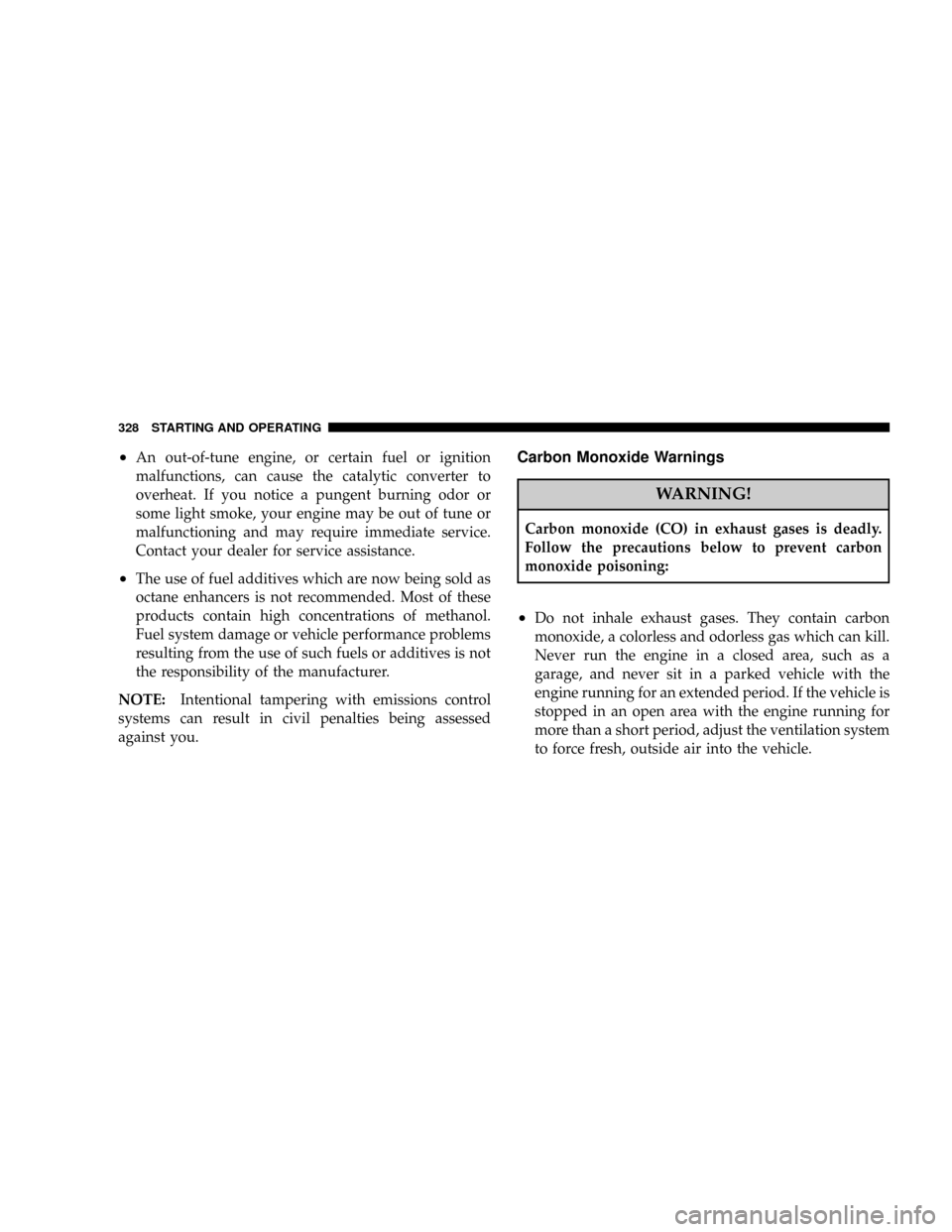Page 309 of 457
Tread Wear Indicators
Tread wear indicators are in the original equipment tires
to help you in determining when your tires should be
replaced.These indicators are molded into the bottom of the tread
grooves. They will appear as bands when the tread depth
becomes 1/16 inch (2 mm). When the tread is worn to the
tread wear indicators, the tire should be replaced.
Many states have laws requiring tire replacement at this
point.
Life of Tire
The service life of a tire is dependent upon varying
factors including but not limited to:
²Driving style
²Tire pressure
²Distance driven
STARTING AND OPERATING 309
5
Page 310 of 457

WARNING!
Tires and spare tire should be replaced after six years,
regardless of the remaining tread. Failure to follow
this warning can result in sudden tire failure. You
could lose control and have an accident resulting in
serious injury or death.
Keep dismounted tires in a cool, dry place with as little
exposure to light as possible. Protect tires from contact
with oil, grease, and gasoline.
Replacement Tires
The tires on your new vehicle provide a balance of many
characteristics. They should be inspected regularly for
wear and correct cold tire inflation pressure. The manu-
facturer strongly recommends that you use tires equiva-
lent to the originals in size, quality and performance
when replacement is needed (refer to the paragraph on
ªTread Wear Indicatorsº). Refer to the ªTire and Loading
Informationº placard for the size designation of your tire.
The service description and load identification will be
found on the original equipment tire. Failure to use
equivalent replacement tires may adversely affect the
safety, handling, and ride of your vehicle. We recommend
that you contact your original equipment or an autho-
rized tire dealer with any questions you may have on tire
specifications or capability.
310 STARTING AND OPERATING
Page 319 of 457

Basic TPMS with EVIC Ð If Equipped
The TPMS uses wireless technology with wheel rim
mounted electronic sensors to monitor tire pressure lev-
els. Sensors, mounted to each wheel as part of the valve
stem, transmit tire pressure readings to the Receiver
Module.
NOTE:It is particularly important, for you to check the
tire pressure in all of your tires regularly and too main-
tain the proper pressure.
The Basic TPMS consists of the following components:
²Receiver Module
²4 Tire Pressure Monitoring Sensors
²Various TPMS Messages, which display in the Elec-
tronic Vehicle Information Center (EVIC).
²Tire Pressure Monitoring Telltale LampThe TPMS Telltale Lamp will illuminate in the instru-
ment cluster, and an audible chime will be activated
when one or more of the four active road tire pressures
are low. In addition, EVIC will display the number of
tire(s) that are low, followed by the ªTire Low Pressureº
text message. Should this occur, you should stop as soon
as possible, check the inflation pressure of each tire on
you vehicle, and inflate each tire to the vehicle's recom-
mended cold placard pressure value. The system will
automatically update and the TPMS Lamp will extin-
guish one the updated tire pressures have been received.
The vehicle may need to be driven for up to 10 minutes
above 15 mph (25 km/h) for the TPMS to receive this
information.
The TPMS Telltale Lamp will flash on and off for 75
seconds, and remain on solid when a system fault is
detected. The system fault will also sound a chime. In
addition, EVIC will display a ªSERVICE TIRE SYSTEM
SOONº text message. If the ignition key is cycled, this
STARTING AND OPERATING 319
5
Page 322 of 457

NOTE:Low pressure in the spare or compact tire
(which has no sensor and therefore not monitored) will
not cause the TPMS Telltale Lamp to illuminate or the
chime to sound.
Should a low tire condition occur on any of the four
active road tire(s), you should stop as soon as possible,
and inflate the low tire(s) that is flashing on the graphic
display to the vehicle's recommended cold placard pres-
sure value. The system will automatically update, the
graphic display of the pressure value(s) will stop flash-
ing, and the TPMS Lamp will extinguish once the up-
dated tire pressure(s) have been received. The vehicle
may need to be driven for up to 10 minutes above 15 mph
(25 km/h) for the TPMS to receive this information.Service Tire System Soon
The TPMS Telltale Lamp will flash on and off for 75
seconds, and remain on solid when a system fault is
detected. The system fault will also sound a chime. In
addition, the EVIC will display aªSERVICE TIRE SYS-
TEM SOONºtext message for 3 seconds. This text
message is then followed by ªÐ к, for the pressure
value(s) indicating which TPMS Sensor(s) is not being
received.
322 STARTING AND OPERATING
Page 323 of 457
If the ignition key is cycled, this sequence will repeat,
providing the system fault still exists If the system fault
no longer exists, the TPMS Telltale Light will no longerflash, theªSERVICE TIRE SYSTEM SOONºtext mes-
sage will not be present, and a pressure value will be
displayed instead of dashes. A system fault can occur
with any of the following scenarios:
1. Jamming due to electronic devices or driving next to
facilities emitting the same radio frequencies as the TPMS
sensors.
2. Installing some form of aftermarket window tinting
that affects radio wave signals.
3. Accumulation of excessive snow and/or ice around
the wheels or wheel housings.
4. Using tire chains on the vehicle.
5. Using wheels/tires not equipped with TPMS sensors.
Check TPM System Display
STARTING AND OPERATING 323
5
Page 325 of 457

FUEL REQUIREMENTS
3.8L GASOLINE ENGINES
The 3.8L engine is designed to meet all
emissions regulations and provide excel-
lent fuel economy and performance when
using high quality unleaded ªregularº
gasoline having an octane rating of 87. The
use of premium gasoline is not recom-
mended. Under normal conditions, the use of premium
gasoline will not provide a benefit over high quality
regular gasolines, and in some circumstances may result
in poorer performance.
4.0L GASOLINE ENGINES
The 4.0L engine is designed to meet all
emissions regulations and provide satisfac-
tory fuel economy and performance whenusing high quality unleaded gasoline having an octane
range of 87 to 89. The manufacturer recommends the use
of 89 octane for optimum performance. The use of
premium gasoline is not recommended. Under normal
conditions, the use of premium gasoline will not provide
a benefit over high quality regular and mid-grade gaso-
lines, and in some circumstances may result in poorer
performance.
Light spark knock at low engine speeds is not harmful to
your engine. However, continued heavy spark knock at
high speeds can cause damage and immediate service is
required.
Poor quality gasoline can cause problems such as hard
starting, stalling and hesitations. If you experience these
symptoms, try another brand of gasoline before consid-
ering service for the vehicle.
STARTING AND OPERATING 325
5
Page 328 of 457

²An out-of-tune engine, or certain fuel or ignition
malfunctions, can cause the catalytic converter to
overheat. If you notice a pungent burning odor or
some light smoke, your engine may be out of tune or
malfunctioning and may require immediate service.
Contact your dealer for service assistance.
²The use of fuel additives which are now being sold as
octane enhancers is not recommended. Most of these
products contain high concentrations of methanol.
Fuel system damage or vehicle performance problems
resulting from the use of such fuels or additives is not
the responsibility of the manufacturer.
NOTE:Intentional tampering with emissions control
systems can result in civil penalties being assessed
against you.
Carbon Monoxide Warnings
WARNING!
Carbon monoxide (CO) in exhaust gases is deadly.
Follow the precautions below to prevent carbon
monoxide poisoning:
²Do not inhale exhaust gases. They contain carbon
monoxide, a colorless and odorless gas which can kill.
Never run the engine in a closed area, such as a
garage, and never sit in a parked vehicle with the
engine running for an extended period. If the vehicle is
stopped in an open area with the engine running for
more than a short period, adjust the ventilation system
to force fresh, outside air into the vehicle.
328 STARTING AND OPERATING
Page 331 of 457

Tighten the fuel filler cap properly and press the
odometer reset button to turn thegASCAPmessage
off.
²Make sure that the fuel filler cap is tightened each time
the vehicle is refueled.
²If the problem continues, the message will appear the
next time the vehicle is started. See your authorized
dealer service center as soon as possible. See Section 7
of this manual for more information.
VEHICLE LOADING
The load carrying capacity of your vehicle is shown in the
charts that follow. This information should be used for
passenger and luggage loading as indicated.
If the seatbacks are folded for carrying cargo, do not
exceed the specified GVWR and GAWR.
Vehicle Certification Label
Your vehicle has a certification label attached to the rear
of the driver's door.
The label contains the following information:
²Name of manufacturer
²Month and year of manufacture
²Gross Vehicle Weight Rating (GVWR)
²Gross Axle Weight Rating (GAWR) front
²Gross Axle Weight Rating (GAWR) rear
²Vehicle Identification Number (VIN)
²Type of Vehicle
²Month Day and Hour of Manufacture (MDH)
The bar code allows a computer scanner to read the
Vehicle Identification Number (VIN).
STARTING AND OPERATING 331
5